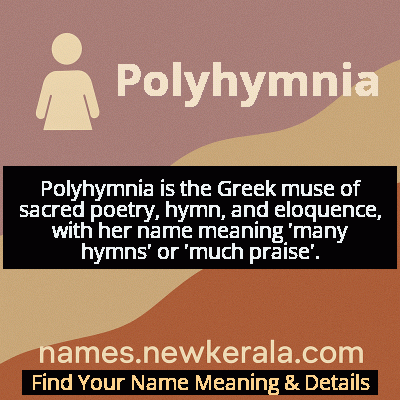Polyhymnia Name Meaning & Details
Origin, Popularity, Numerology Analysis & Name Meaning of Polyhymnia
Discover the origin, meaning, and cultural significance of the name POLYHYMNIA. Delve into its historical roots and explore the lasting impact it has had on communities and traditions.
Name
Polyhymnia
Gender
Female
Origin
Greek
Lucky Number
3
Meaning of the Name - Polyhymnia
Polyhymnia is the Greek muse of sacred poetry, hymn, and eloquence, with her name meaning 'many hymns' or 'much praise'.
Polyhymnia - Complete Numerology Analysis
Your Numerology Number
Based on Pythagorean Numerology System
Ruling Planet
Jupiter
Positive Nature
Optimistic, inspirational, and creative.
Negative Traits
Scattered, exaggerating.
Lucky Colours
Yellow, gold, purple.
Lucky Days
Thursday.
Lucky Stones
Yellow sapphire.
Harmony Numbers
1, 2, 9.
Best Suited Professions
Arts, writing, communication.
What People Like About You
Creativity, optimism.
Famous People Named Polyhymnia
Polyhymnia (Mythological)
Greek Muse
Presided over sacred poetry, hymns, and eloquence in Greek mythology
Polyhymnia of Thebes
Ancient Poet
Composed religious hymns in 4th century BCE Greece
Polyhymnia Hymnia
Classical Singer
Revived ancient Greek musical traditions in modern performances
Name Variations & International Equivalents
Click on blue names to explore their detailed meanings. Gray names with will be available soon.
Cultural & Historical Significance
Extended Personality Analysis
Those bearing the name Polyhymnia typically exhibit a complex blend of artistic sensitivity and intellectual depth. They are often perceived as wise beyond their years, possessing an innate understanding of human nature and spiritual matters. Their creative expression tends to be thoughtful and layered, whether they work in traditional arts or apply their imaginative talents to scientific or humanitarian fields. Polyhymnias are frequently drawn to teaching and mentoring roles, where they can share their insights and inspire others to pursue excellence. They value authenticity and depth in all aspects of life, often serving as the 'moral compass' in their social circles. While they may appear reserved, they form intensely loyal relationships with those who appreciate their nuanced perspective on life. Their strength lies in their ability to find meaning in complexity and to communicate profound ideas with clarity and grace. They often excel in fields requiring both analytical thinking and creative problem-solving, making them valuable contributors to collaborative projects and innovative endeavors.
Modern Usage & Popularity
In contemporary naming practices, Polyhymnia represents the growing trend toward unique, meaningful names with classical roots. While statistically rare, its usage has seen a gradual increase in the 21st century, particularly among educated urban professionals and families with Greek heritage. The name appeals to parents seeking alternatives to more common mythological names like Athena or Diana, offering similar classical weight with greater distinctiveness. Modern Polyhymnias often navigate the practical challenges of an unusual name by adopting accessible nicknames while maintaining the formal version for professional contexts. The name's association with creativity and spirituality makes it particularly popular in artistic communities and among parents who value cultural literacy. Social media has played a role in its modest revival, with parenting blogs and naming forums occasionally featuring Polyhymnia as an 'undiscovered gem' from classical mythology. Its usage remains concentrated in North America and Europe, with occasional appearances in Greece itself, where ancient names are experiencing a renaissance among younger generations seeking to reconnect with their cultural heritage.
Symbolic & Spiritual Meanings
Polyhymnia embodies the profound symbolism of sacred creativity and the transformative power of artistic expression. Her name represents the idea that true art serves as a bridge between the human and divine, elevating ordinary experience through the lens of beauty and meaning. She symbolizes the contemplative aspect of creativity - the necessary silence and reflection that precedes meaningful expression. In psychological terms, Polyhymnia represents the integration of spiritual values with creative output, suggesting that the most enduring art emerges from deep personal conviction and ethical commitment. Her traditional association with geometry and meditation positions her as a symbol of the connection between mathematical precision and artistic inspiration, between structured thought and free expression. In modern contexts, Polyhymnia has come to represent the search for authenticity in an increasingly commercialized creative landscape, reminding us that art retains its power when it serves higher purposes than mere entertainment or profit. She stands as an enduring symbol of the human capacity to find transcendence through disciplined creative practice and heartfelt expression.

